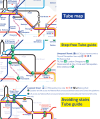Can you explain please? The current TfL tube map shows Farringdon (Thameslink) as "Step-free from train to street", and Crossrail says the same about the Elizabeth line there. I understand the Circle line at Farringdon is only step-free from street to platform, which is why I would expect all the wheelchair users and mobility scooters to go via Farringdon (to get to OOC and Heathrow, rather than use the Circle line).
I've just been to Farringdon station itself to check the situation as I dont think its that good (I also took a fresh set of photographs of the facilities for the sake of it and which I can refer to if anyone challenges me.) That I undertook before I even begin writing any replies.
I also did some scrutiny of the Crossrail planning documents to make sure the facilities are what they are because what TfL says isn't what is actually on the ground. I've written quite a few times on Farringdon but thought it best just to make a visit to make sure my knowledge was still current.
Basically Farringdon only offers direct access for PRM from the
southbound Thameslink platforms. Not good for those wanting to come from the east (Shenfield/Abbey Wood branches) and then changing to northbound Thameslink.
The only way to get from the northbound platforms to the Elizabeth Line is to go via the ticket hall. If one can walk and is quite mobile there's of course direct access to the Elizabeth Line via the shiny new concourse with all its fantastic artwork but for others (wheelchair users, mobility restricted etc) there isn't even that.
The other problems, yes there's more, is the level boarding at Farringdon is dire. The ramps (Harrington humps if anyone wants the proper name for these) are sited quite a way north of the actual lifts (these ramps are on both the north and southbound Thameslink platforms) however the rather narrow platforms means one has the task of negotiating these (especially if they're crowded) and that simply to reach the far end of the long Thameslink platforms for the lifts. The gap on other parts of the platforms is considerable which means only the ramped sections can be used and as I pointed out they're quite a way north of the Elizabeth Line interchange.
If one alights from southbound Thameslink, well that's somewhat of a blessing. if they alight from the northbound and in the wrong place well that's going to be a nightmare. Not only that they'll have to go right to the southern end of the platforms and then up to the ticket hall and then down to the Elizabeth Line.
Farringdon might be the best station on the planet as it currently stands, but for some its going to be a major obstacle course.
There's lift access between all platforms at Farringdon?
Only to street level not to the Elizabeth line.

